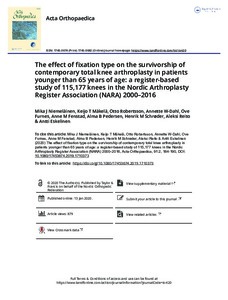The effect of fixation type on the survivorship of contemporary total knee arthroplasty in patients younger than 65 years of age: a register-based study of 115,177 knees in the Nordic Arthroplasty Register Association (NARA) 2000-2016
Mika J. Niemeläinen; Alma B. Pedersen; Anne M. Fenstad; Otto Robertsson; Keijo T. Mäkelä; Ove Furnes; Henrik M. Schrøder; Antti Eskelinen; Annette W-Dahl; Aleksi Reito
The effect of fixation type on the survivorship of contemporary total knee arthroplasty in patients younger than 65 years of age: a register-based study of 115,177 knees in the Nordic Arthroplasty Register Association (NARA) 2000-2016
Mika J. Niemeläinen
Alma B. Pedersen
Anne M. Fenstad
Otto Robertsson
Keijo T. Mäkelä
Ove Furnes
Henrik M. Schrøder
Antti Eskelinen
Annette W-Dahl
Aleksi Reito
TAYLOR & FRANCIS LTD
Julkaisun pysyvä osoite on:
https://urn.fi/URN:NBN:fi-fe2021042821593
https://urn.fi/URN:NBN:fi-fe2021042821593
Tiivistelmä
Background and purpose - Cemented fixation is regarded as the gold standard in total knee arthroplasty (TKA). Among working-age patients, there has been controversy regarding the optimal fixation method in TKA. To address this issue, we conducted a register-based study to assess the survivorship of cemented, uncemented, hybrid, and inverse hybrid TKAs in patients aged < 65 years.
Patients and methods - We used the Nordic Arthroplasty Register Association data of 115,177 unconstrained TKAs performed for patients aged < 65 years with primary knee osteoarthritis over 2000-2016. Kaplan-Meier (KM) survival analysis with 95% confidence intervals (CI) and Cox multiple-regression model with adjustment for age, sex, and nation were used to compare fixation methods in relation to revision for any reason.
Results - The 10-year KM survivorship of cemented TKAs was 93.6% (95% CI 93.4-93.8), uncemented 91.2% (CI 90.1-92.2), hybrid 93.0% (Cl 92.2-93.8), and inverse hybrid 96.0% (CI 94.1-98.1). In the Cox model, hybrid TKA showed decreased risk of revision after 6 years' follow-up compared with the reference group (cemented) (hazard ratio [HR] 0.5 [CI 0.4-0.8]), while uncemented TKAs showed increased risk of revision both < 1 year (HR 1.4 [1.1-1.7]) and > 6 years' (HR 1.3 [1.0-1.7]) follow-up compared to the reference.
Interpretation - Both cemented and hybrid TKAs had 10-year survival rates exceeding 92->93% in patients aged < 65 years. Cemented TKA, however, was used in the vast majority (89%) of the operations in the current study. As it performs reliably in the hands of many, it still deserves the status of gold standard for TKA in working-age patients.
Kokoelmat
- Rinnakkaistallenteet [19207]
